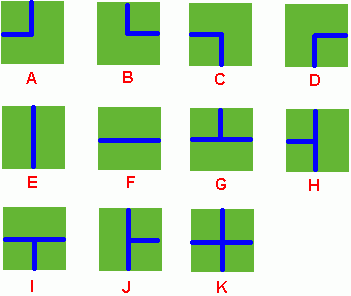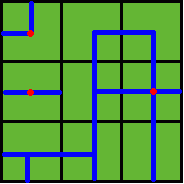标签:
Farm Irrigation
Time Limit: 2000/1000 MS (Java/Others) Memory Limit: 65536/32768 K (Java/Others)
Total Submission(s): 6628 Accepted Submission(s): 2856
Problem Description
Benny has a spacious farm land to irrigate. The farm land is a rectangle, and is divided into a lot of samll squares. Water pipes are placed in these squares. Different square has a different type of pipe. There are 11 types of pipes, which is marked from A
to K, as Figure 1 shows.
 Figure 1
Figure 1
Benny has a map of his farm, which is an array of marks denoting the distribution of water pipes over the whole farm. For example, if he has a map
ADC
FJK
IHE
then the water pipes are distributed like
 Figure 2
Figure 2
Several wellsprings are found in the center of some squares, so water can flow along the pipes from one square to another. If water flow crosses one square, the whole farm land in this square is irrigated and will have a good harvest in autumn.
Now Benny wants to know at least how many wellsprings should be found to have the whole farm land irrigated. Can you help him?
Note: In the above example, at least 3 wellsprings are needed, as those red points in Figure 2 show.
Input
There are several test cases! In each test case, the first line contains 2 integers M and N, then M lines follow. In each of these lines, there are N characters, in the range of ‘A‘ to ‘K‘, denoting the type of water pipe over the corresponding square. A negative
M or N denotes the end of input, else you can assume 1 <= M, N <= 50.
Output
For each test case, output in one line the least number of wellsprings needed.
Sample Input
2 2
DK
HF
3 3
ADC
FJK
IHE
-1 -1
Sample Output
Author
ZHENG, Lu
看到这题目,是在最下生成树专题里面,不知道怎么做。。。
去网上看别人的博客,发现可以深搜水过。。于是乎,看了一下思路。恩,简单的DFS
#include<stdio.h>
#include<string.h>
#include<iostream>
#include<algorithm >
using namespace std;
int n,m,vis[55][55];
char map[55][55];
int dir[][2]={
-1,0,0,-1,1,0,0,1
};
int liantong[][4]={ //up,left,down,right
{1,1,0,0},{1,0,0,1},{0,1,1,0 },{0, 0,1,1},{1,0,1,0},{0,1,0,1},{1,1,0,1},{1,1,1,0},{0,1,1,1}
,{1,0,1,1 },{1,1,1,1} //分别代表A-K的四个方向能否连接。1代表能,0代表不能。
};
int check(int x,int y)
{
if(x<0||y<0||x>=m||y>=n||vis[x][y]==1)
return 0;
return 1;
}
void dfs(int x,int y)
{
int i,j;
for(i=0;i<4;i++)
{
int xx=x+dir[i][0];
int yy=y+dir[i][1];
if(check(xx,yy)&&liantong[map[x][y]-‘A‘][i]&&liantong[map[xx][yy]-‘A‘][(i+2)%4]) //liantong那里表示当前的一块能否连通和要连得那一块能够连通
{
vis[xx][yy]=1;
dfs(xx,yy);
}
}
}
int main()
{
int i,j,k,t;
while(scanf("%d%d",&m,&n)!=EOF)
{
if(n==-1&&m==-1)break;
t=0;
memset(vis,0,sizeof(vis));
for(i=0;i<m;i++)
for(j=0;j<n;j++)
cin>>map[i][j];
for(i=0;i<m;i++)
for(j=0;j<n;j++)
{
if(!vis[i][j]){
dfs(i,j);
t++;
}
}
printf("%d\n",t);
}
}
hdu1198 Farm Irrigation(DFS)
标签:
原文地址:http://blog.csdn.net/aaaaacmer/article/details/45918885

